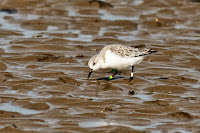On the 10th of September, three colour ringed Sanderling
were spotted among a flock of 208 on Sandymount Strand, doing the usual
Sanderling thing – zipping along right in front of the waves, like clock-work
toys in fast-forward. All three birds were ringed in
Iceland in 2011, and have wintered in Ireland every year since!
G1RWGR was ringed on the 18th May 2011 in Sandgerði, and was last seen in Iceland on the 25th May 2011. He was picked up again in Poolbeg in Dublin Bay on the 31st July 2011, where he spent the winter, having his rings read numerous times between then and the 24th April 2012. The next sighting of G1RWGR was on the 30th July 2012, back in Poolbeg once again.
 |
| G1RWGR John Fox |
Sanderlings don’t breed until
they are two years old, so this guy wouldn’t have made the trip all the way
the breeding grounds in Greenland or Canada in 2012. It’s likely that he did breed this year however, having last being seen in Dublin Bay on the 25th
February and not being picked up again until the 10th September.
Here's a quick summary of the re-sightings for the other two birds.
Here's a quick summary of the re-sightings for the other two birds.
G2WWYG
22nd May 2011 - ringed
in Sandgerði in Iceland
13th August 2011 –
first spotted in Poolbeg, north Sandymount Strand
2011/12 winter – numerous
sightings on Sandymount Strand
20th February 2012 –
last seen in Booterstown Strand, Dublin
15th May 2012 – in
Sandgerði harbour, Iceland
20th August 2012 –
back in Poolbeg, north Sandymount Strand again
2012/13 winter - numerous sightings on Sandymount Strand
25th February 2013 –
last Dublin sighting
10th September –
picked up on Sandymount Strand once again
 |
| G2WGGW John fox |
G2WGGW
30th May 2011 - ringed
in Sandgerði in Iceland
15th September 2011 –
first spotted in Booterstown, south Dublin Bay
2011/12 winter – numerous
sightings on Sandymount Strand
15th May 2012 – last
seen in Poolbeg, Ireland
19th May 2012 – in
Sandgerði harbour, Iceland (1,500 km in 4 days!!)
26th July 2012 – back
in Poolbeg, north Sandymount Strand
2012/13 winter – numerous sightings on Sandymount Strand
12th February 2013 –
last Dublin sighting in Booterstown
10th September – picked up on
Sandymount Strand once again


.jpg)
+(Richard+T+Mills).jpg)



